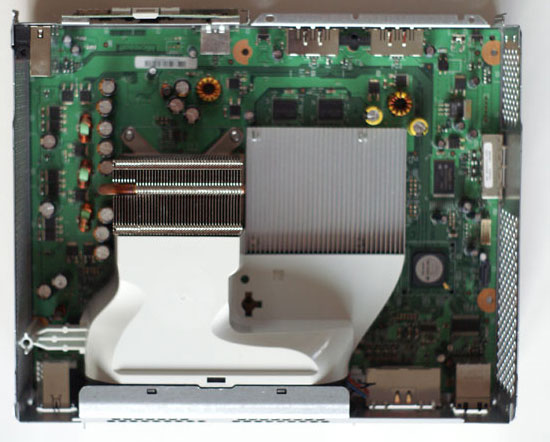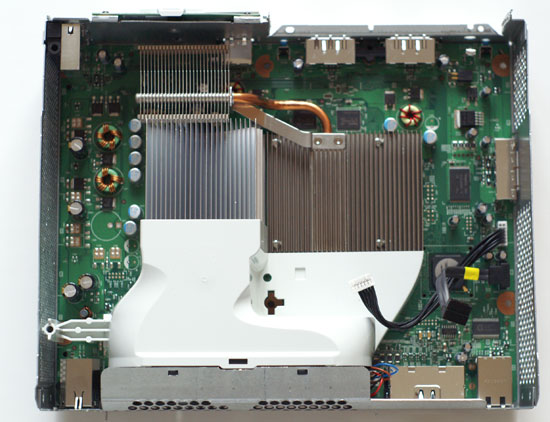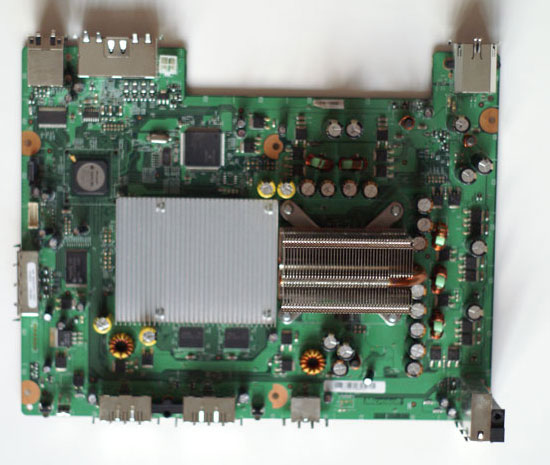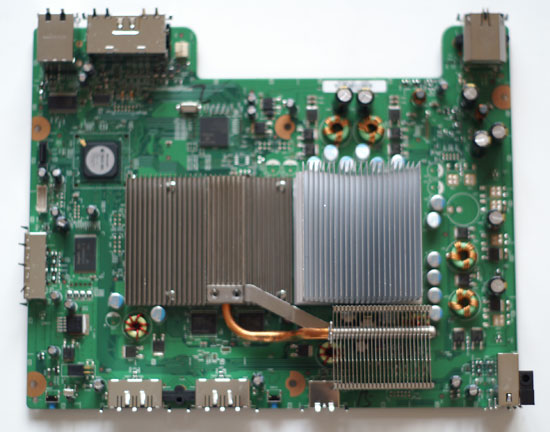Microsoft's Xbox 360 goes 65nm: Falcon Dissection and Power Consumption
by Anand Lal Shimpi on November 15, 2007 11:55 PM EST- Posted in
- Smartphones
- Mobile
Hardware Changes
We wanted to see the new CPU up close, so we went straight to our original Xbox 360 disassembly instructions which, surprisingly enough, still work on the new consoles. There are a couple of changes, the only torx driver we used was a T12 and the torx screws on the bottom of the console are now a mixture of gold, silver and black whereas they used to be just silver and black. Other than those changes, the entire process can be completed just the way we diagrammed it over two years ago.
With the tops off our Xboxes, we can look at some of the changes first hand:

The original Xbox 360

The new Xbox 360, the additional heatsink you see at the top of the image was originally added in an earlier model of the Xbox 360, it makes another appearance here in the Falcon
The cooling setup is definitely less beefy than with the original console:

The original Xbox 360, note the heatpipe running through the CPU heatsink on the right. The GPU heatsink is on the left.

The new Xbox 360, note the lack of a heatpipe going through the CPU's heatsink (right) and the additional heatsink for the GPU (bottom right).
It's amazing how little has actually changed with the internal design of the console, obviously some components have changed (e.g. DRAM) but the general layout remains the same after two years.










46 Comments
View All Comments
Deusfaux - Friday, November 16, 2007 - link
that the GPU isn't yet, and that a platform with both @ 65nm is still coming down the pipe, expected next year and has the codename of "Jasper"Where do I get this information? Oh, I dunno...
http://www.dailytech.com/article.aspx?newsid=9248">http://www.dailytech.com/article.aspx?newsid=9248
zephyrprime - Sunday, November 18, 2007 - link
It doesn't matter what MS says. Anandtech has physically measured the dies and thus has hard evidence that what MS says is false. What's more, given the die size of the parts, it seems like the Falcon is actually a shrink to 80nm for both processor and GPU, not a shrink to 65nm for the CPU as MS has stated.j00k - Friday, November 16, 2007 - link
i wonder why it takes MSFT so long to make the move in die shrink. CPU's already been in 65nm for quite awhile. By the time they transition to 65nm for gpu next year, everyone would have been on 45nm. im sure the technology's there already but what's the holdup?Deusfaux - Friday, November 16, 2007 - link
ok so MSFT didnt say it but stillj00k - Friday, November 16, 2007 - link
The new xbox 360 mobo also appears to have some solid capacitors, which the old didn't seem to have any at all. I'm surprised that wasn't pointed out as I'm sure it should help quite a bit in keeping the system stable even at high temps. It's certainly a huge deal in the desktop mobo arena.sprockkets - Friday, November 16, 2007 - link
wonder why they did that, seeing as how they do not need to last long anyhow. Well, as long as the other caps were rubycon or japanese, that is ok. Wonder what the cost diff is between them and solid caps?I like the last graph that the consoles use only 2.3 watts and 2.8 watts during the game.
slashbinslashbash - Friday, November 16, 2007 - link
Good to see someone scientifically documenting the differences. I had read before that Falcon had only reduced the GPU size, not CPU. Good to hear that it's both.... I guess I'll probably bite the bullet and finally buy an Xbox 360 this holiday season.yacoub - Thursday, November 22, 2007 - link
well the article doesn't really answer the important questions, like whether or not the GPU and CPU run cooler, so not sure why you find the conclusion that the hardware has changed enough reason to buy when we don't know if the changes actually make a bit of difference toward addressing the pressing issue of RRODs.Orbs - Friday, November 16, 2007 - link
What about heat? Can you put a thermometer through the "flashlight holes" in the case to see if temps improved too? Die shrinks should help but the less intense heatsink may offset that.In terms of the RRoD question, if the cause was heat (which is not confirmed) a test like that would help show if this will in fact increase reliability.
Jopopsy - Friday, November 16, 2007 - link
Yes Anand, please post some information about the heat coming off the Zephyr and Falcon PCs !!! Most of us, from a practical perspective, don't really care so much about the die size as much as we care about the heat (as the heat has been tied to RROD).I for one bought a Elite 4 days ago. It was not a Falcon. It had a LG/Hitachi drive in it and it was definitely a Zephyr board. It was too loud for my tastes, and it was H O T ! ! !. It felt like a blow dryer out the back of the unit and my table was actually hot to the touch right behind my system.
Went back to the store, found a Falcon (Premium 360 HDMI Holiday bundle LOT 739 Team FDOU - components verified w/ flashlight inspection). It has a Toshiba drive in it, and after 2 hours of Halo 3 it was only warm out the back (remarkable differance).
I have some confidance that this Xbox might last (if it RRODs on me anytime soon I'm getting a PS3).